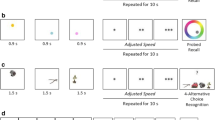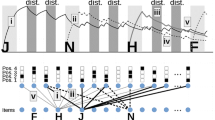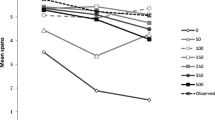Abstract
Maintenance of verbal information within human working memory occurs through two main complementary mechanisms: articulatory rehearsal and refreshing. Both are well-described in the literature but very few computational models have attempted to describe the ways they interact to maintain information. Because these interactions are difficult to apprehend without computer simulations, this paper presents a possible implementation of rehearsal within TBRS* (Time-Based Resource-Sharing Theory), a computational model operating only with refreshing and based on the TBRS verbal theory. Computer code is available at https://osf.io/taqmv/. The implementation was tested on different benchmark findings and could replicate all main effects attributed to rehearsal, while still being accountable for the same effect as TBRS*. Four aspects of our rehearsal implementation are discussed with respect to the human behavior that is intended to be described: first, the primacy and recency effects in relation to the short-term property of rehearsal and the long-term purpose of refreshing; second, the moment at which long-term memory influences working memory performance during working memory tasks in reference to the redintegration hypothesis; third, the interplay between the two maintenance mechanisms; finally, positional coding as the appropriate representation for rehearsal.












Similar content being viewed by others
Explore related subjects
Discover the latest articles, news and stories from top researchers in related subjects.Notes
Benchmark #5.2.4 in [26].
Benchmark #3.1 in Oberauer et al. [26].
Benchmark #5.2.1 in Oberauer et al. [26].
Benchmark #7 in Oberauer et al. [26].
Benchmark #8.1.1 in Oberauer et al. [26].
It is worth noting that LTM is here a fixed component; our model does not include any LTM learning or updating from WM.
We also tested values of 0, 40, 100, 150, and 200 ms and found that values above 100 ms did not reproduce human data well, suggesting that forgotten items do not spend as much time as maintained items in rehearsing. However, forgotten items probably induce a delay in recitation, since simulations with null gaps also led to poor reproduction of human behavior.
Benchmark #5.2.4 in Oberauer et al. [26].
Benchmark #3.1 in Oberauer et al. [26].
Benchmark 5.2.1 in Oberauer et al. [26].
Benchmark #7 in Oberauer et al. [26].
Benchmark #8.1.1 in Oberauer et al. [26].
References
Oberauer K, Lewandowsky S, Farrell S, Jarrold C, Greaves M. Modeling working memory: an interference model of complex span. Psychon Bull Rev. 2012;19:779–819.
Barrouillet P, Portrat S, Vergauwe E, Diependaele K, Camos V. Further evidence for temporal decay in working memory. J Exp Psychol Learn Mem Cogn. 2011;37:1302–17.
Camos V, Johnson M, Loaïza V, Portrat S, Souza A, Vergauwe E. What is attentional refreshing in working memory? Ann N Y Acad Sci. 2018;1424(1):19–32.
Baddeley AD. Working memory. New York: Oxford University Press; 1986.
Bailey H, Dunlosky J, Kane MJ. Contribution of strategy use to performance on complex and simple span tasks. Mem Cognit. 2011;39:447–61.
Barrouillet P, Bernardin S, Camos V. Time constraints and resource sharing in adults’ working memory spans. J Exp Psychol Gen. 2004;133(1):83–100.
Oberauer K, Lewandowsky S. Modeling working memory: a computational implementation of the Time-Based Resource-Sharing theory. Psychon Bull Rev. 2011;18(1):10–45.
Glavan JJ, Houpt JW. An integrated working memory model for time based resource sharing. Top Cogn Sci. 2019;11(1):261–76.
Anderson JR. How can the human mind occur in the physical universe? New York: Oxford University Press; 2007.
Lemaire B, Portrat S. A computational model of working memory integrating time-based decay and interference. Front Psychol. 2018;9:416.
Barrouillet P, Bernardin S, Portrat S, Vergauwe E, Camos V. Time and cognitive load in working memory. J Exp Psychol Learn Mem Cogn. 2007;33(3):570.
Lewandowsky S, Oberauer K. Rehearsal in serial recall: an unworkable solution to the nonexistent problem of decay. Psychol Rev. 2015;122(4):674–99.
Conway AR, Kane MJ, Bunting MF, Hambrick DZ, Wilhelm O, Engle RW. Working memory span tasks: aa methodological review and user’s guide. Psychon Bull Rev. 2005;12(5):769–786xx.
McCabe DP. The role of covert retrieval in working memory span tasks: evidence from delayed recall tests. J Mem Lang. 2008;58:480–94.
Johnson MK, Reeder JA, Raye CL, Mitchell KJ. Second thoughts versus second looks: an age-related deficit in reflectively refreshing just-active information. Psychol Sci. 2002;13:64–7.
Pashler H. The psychology of attention. Cambridge, MA: MIT Press; 1998.
Cowan N. An embedded-process model of working memory. In: Miyake A, Shah P, editors. Models of working memory: Mechanisms of active maintenance and executive control. Cambridge: Cambridge University Press; 1999. p. 62–101.
Barrouillet P, Portrat S, Camos V. On the law relating processing to storage in working memory. Psych Rev. 2011;118(2):175–92.
Barrouillet P, Camos V. Working memory: Loss and reconstruction. Hove: Psychology Press; 2015.
Baddeley AD, Hitch G. Working memory. Psychol. Learn Motiv. 1974;8:47–89.
Jolicœur P, Dell’Acqua R. The demonstration of short-term consolidation. Cogn Psychol. 1998;36(2):138–202.
Paulesu E, Frith CD, Frackowiak RS. The neural correlates of the verbal component of working memory. Nature. 1993;362(6418):342–5.
Baddeley AD, Eysenck M, Anderson MC. Memory. Hove: Psychology Press; 2009.
O’Shaughnessy D. A multispeaker analysis of durations in read French paragraphs. J Acoust Soc Am. 1984;76:1664–72.
Page MD, Norris D. The primacy model: a new model of immediate serial recall. Psych Rev. 1998;105(4):761–81.
Oberauer K, Lewandowsky S, Awh E, Brown GDA, Conway A, Conway N, et al. Benchmarks for models of short-term and working memory. Psychol Bull. 2018;104(9):885–958.
Gupta P, Lipinski J, Aktunc E. Reexamining the phonological similarity effect in immediate serial recall: the roles of type of similarity, category cuing, and item recall. Mem Cognit. 2005;33(6):1001–16.
Conrad R. Acoustic confusions in immediate memory. Br J Psychol. 1964;55(1):75–84.
Lewandowsky S, Farrell S. Phonological similarity in serial recall: constraints on theories of memory. J Mem Lang. 2008;58(2):429–48.
Baddeley AD, Thomson N, Buchanan M. Word length and the structure of short-term memory. J Verbal Learning Verbal Behav. 1975;14(6):575–89.
Bhatarah P, Ward G, Smith J, Hayes L. Examining the relationship between free recall and immediate serial recall: Similar patterns of rehearsal and similar effects of word length, presentation rate, and articulatory suppression. Mem Cognit. 2009;37(5):689–713.
Murray DJ. The role of speech responses in short-term memory. Can J Exp Psychol. 1967;21:263–76.
Camos V, Mora G, Oberauer K. Adaptive choice between articulatory rehearsal and attentional refreshing in verbal working memory. Mem & Cognit. 2001;39(2):231–44.
Naveh-Benjamin M, Jonides J. Maintenance rehearsal: a two-component analysis. J Exp Psychol Learn Mem Cogn. 1984;10(3):369–85.
Vergauwe E, Camos V, Barrouillet P. The impact of storage on processing: how is information maintained in working memory? J Exp Psychol Learn Mem Cogn. 2014;40:1072–95.
Thalmann M, Souza AS, Oberauer K. Revisiting the attentional demands of rehearsal in working-memory tasks. J Mem Lang. 2019;105:1–18.
Camos V, Portrat S. The impact of cognitive load on delayed recall. Psychon Bull Rev. 2015;22(4):1029–34.
Jarjat G, Hoareau V, Plancher G, Hot P, Lemaire B, Portrat S. What makes working memory traces stable over time? Ann N Y Acad Sci. 2018;1424(1):149–60.
Loaiza VM, McCabe DP. The influence of aging on attentional refreshing and articulatory rehearsal during working memory on later episodic memory performance. Neuropsychol Dev Cogn B Aging Neuropsychol Cogn. 2013;20(4):471–93.
Camos V, Lagner P, Barrouillet P. Two maintenance mechanisms of verbal information in working memory. J Mem Lang. 2009;61(3):457–69.
Raye CL, Johnson MK, Mitchell KJ, Reeder JA, Greene EJ. Neuroimaging a single thought: dorsolateral PFC activity associated with refreshing just-activated information. Neuroimage. 2002;15(2):447–53.
Raye CL, Johnson MK, Mitchell KJ, Greene EJ, Johnson MR. Refreshing: a minimal executive function. Cortex. 2007;43(1):135–45.
Gruber O, von Cramon DY. The functional neuroanatomy of human working memory revisited: evidence from 3-T fMRI studies using classical domain-specific interference tasks. Neuroimage. 2003;19(3):797–809.
Trost S, Gruber O. Evidence for a double dissociation of articulatory rehearsal and non-articulatory maintenance of phonological information in human verbal working memory. Neuropsychobiology. 2012;65(3):133–40.
Gaillard V, Barrouillet P, Jarrold C, Camos V. Developmental differences in working memory: where do they come from? J Exp Child Psychol. 2011;110(3):469–79.
Baumans C, Adam S, Seron X. Effect of cognitive load on working memory forgetting in aging. Exp Psychol. 2012;59(6):311–21.
Lemaire B, Pageot A, Plancher G, Portrat S. What is the time course of working memory attentional refreshing? Psychon Bull Rev. 2018;25(1):370–85.
Camos V, Barrouillet P. Attentional and non-attentional systems in the maintenance of verbal information in working memory: the executive and phonological loops. Front Hum Neurosci. 2014;8:900.
Jarrold C, Tam H, Baddeley AD, Harvey CE. How does processing affect storage in working memory tasks? Evidence for both domain-general and domain-specific effects. J Exp Psychol Learn Mem Cogn. 2011;37:688–705.
Vergauwe E, Cowan N. Attending to items in working memory: evidence that refreshing and memory search are closely related. Psychon Bull Rev. 2015;22:1001–6.
Lucidi A, Langerock N, Hoareau V, Lemaire B, Camos V, Barrouillet P. Working memory still needs verbal rehearsal. Mem Cognit. 2016;44(2):197–206.
Glanzer M, Cunitz AR. Two storage mechanisms in free recall. J Verbal Learning Verbal Behav. 1966;5(4):351–60.
Glanzer M. Storage mechanisms in recall. Psychology of learning and motivation. 1972;5:129–93.
Craik FI. The fate of primary memory items in free recall. J Verbal Learning Verbal Behav. 1970;9(2):143–8.
Loaiza VM, Camos V. The role of semantic representations in verbal working memory. J Exp Psychol Learn Mem Cogn. 2018;44(6):863–81.
Rose NS, Craik FIM. A processing approach to the working memory/long-term memory distinction: evidence from the levels-of-processing span task. J Exp Psychol Learn Mem Cogn. 2012;38(4):1019–29.
Hulme C, Roodenrys S, Brown G, Mercer R. The role of long-term memory mechanisms in memory span. Br J Psychol. 1995;86:527–36.
Schweickert R. A multinomial processing tree model for degradation and redintegration in immediate recall. Mem Cognit. 1993;21(2):168–75.
Kowialiewski B, Majerus S. Testing the redintegration hypothesis by a single probe recognition paradigm. Memory. 2018;26(9):1256–64.
Burgess N, Hitch GJ. Memory for serial order: a network model of the phonological loop and its timing. Psych Rev. 1999;106(3):551–81.
Burgess N, Hitch GJ. A revised model of short-term memory and long-term learning of verbal sequences. J Mem Lang. 2006;55(4):627–52.
Botvinick M, Plaut DC. Short-term memory for serial order: a recurrent neural network model. Psych Rev. 2006;113:201–33.
Portrat S, Lemaire B. Is attentional refreshing in working memory sequential? A computational modeling approach Cognit Comput. 2015;7(3):333–45.
Portrat S, Guida A, Phénix T, Lemaire B. Promoting the experimental dialogue between working memory and chunking: behavioral data and simulation. Mem Cognit. 2016;44(3):420–34.
Vergauwe E, Ricker TJ, Langerock N, Cowan N. What do people typically do between list items? The nature of attention-based mnemonic activities depends on task context. J Exp Psychol Learn Mem Cogn. 2019;45(5):779–94.
Ward G, Tan L. Control processes in short-term storage: retrieval strategies in immediate recall depend upon the number of words to be recalled. Mem Cognit. 2019;47(4):658–82.
Lewandowsky S, Murdock BB. Memory for serial order Psych Rev. 1989;96:25–57.
Henry LA, Millar S. Why does memory span improve with age? A review of the evidence for two current hypotheses, Eur J Cogn Psychol. 1993;5(3):241–87.
Souza AS, Oberauer K. Does articulatory rehearsal help immediate serial recall? Cogn Psychol. 2018;107:1–21.
Acknowledgements
This work was funded by the French National Research Agency (ANR) (ANR-17-CE28-0013-03) under the CHUNKED project.
Author information
Authors and Affiliations
Corresponding author
Ethics declarations
Ethical Approval
This article does not contain any studies with human participants performed by any of the authors.
Rights and permissions
About this article
Cite this article
Lemaire, B., Heuer, C. & Portrat, S. Modeling Articulatory Rehearsal in an Attention-Based Model of Working Memory. Cogn Comput 13, 49–68 (2021). https://doi.org/10.1007/s12559-020-09791-9
Received:
Accepted:
Published:
Issue Date:
DOI: https://doi.org/10.1007/s12559-020-09791-9




